Manor of Upton Pyne
The Manor of Upton Pyne is a former manor in the county of Devon, England. The manor included the village of Upton Pyne situated about 3 miles northwest of the historic centre of Exeter. The manor house is Pynes House.
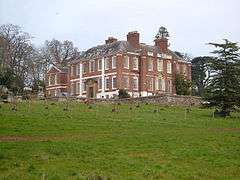
Descent of the manor
Pyne
The manor of Upton Pynes was long held by the Pyne family and Herebert de Pino, as he was called in a Latin charter, held the manor during the reign of King Henry I[1][2] (1100–1135). He was succeeded successively by Simon, Herebert, Simon, Sir Herebert, Sir Herebert, John, William, Edmond, and Nicholas Pyne. Nicholas Pyne died without male children and left his daughter Constance Pyne as his sole heiress. She married William Larder, to which family the manor of Upton Pyne passed.[3]
Larder
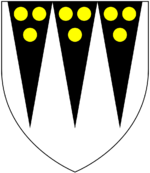
William Larder married Constance Pyne, heiress of Upton Pyne. He was succeeded by his son Edmond Larder (died 1521),[4] whose effigy survives in Upton Pyne Church, set within a Tudor-arched recess. It is inscribed above in Latin: Orate pro a(n)i(m)a Edm(u)ndi Larder Ar(migeri) ("Pray ye all for the soul of Edmund Larder, Esquire"). Below are four sculpted heraldic shields.[5] Edmond married Isabel (or Elizabeth) Bonville, one of the daughters and co-heiresses of John Bonville (died 1491), lord of the manor of Combe Raleigh,[6] Devon, and bastard son of the magnate William Bonville, 1st Baron Bonville (died 1461).[7] He was followed by his son Tristram Larder (1515–1547), who married Mary Stucley, a daughter of Sir Hugh Stucley (1496–1559),[8] lord of the manor of Affeton and Sheriff of Devon in 1545. He was followed by his son Humphrey Larder (died 1588), whose chest tomb survives in Upton Pyne Church. Humphrey died without male children and left as his sole heiress his only daughter, Margaret Larder,[9] who married Anthony Coplestone (died 1648) of Weare Gifford,[4] who made Upton Pyne his residence.[10]
Coplestone
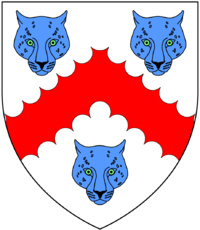
Anthony Coplestone (died 1648) inherited Upton Pyne on his marriage to the heiress Margaret Larder. He was a son of Anthony Coplestone of Weeke (or Wike), Devon, by his wife Mary Parker, a daughter of John Parker of North Molton,[11] an ancestor of the Parker Earls of Morley of Saltram House. He was descended from the Coplestones of Instow, a junior branch of the Coplestones of Coplestone in Devon,[12] an ancient Devon family. Although Anthony Coplestone had a son, in 1640 he sold Upton Pyne to his son-in-law Sir John Coplestone (d.1650-1)[13] of Nash in Dorset, knighted by Oliver Cromwell, the husband of his 6th daughter Grace Coplestone[11] and father of the Roundhead commander John Copleston.
Stafford
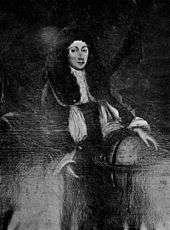
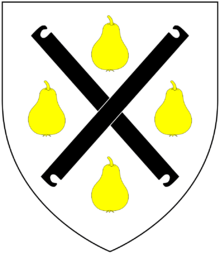
The present house was built by Hugh Stafford (1674–1734),[14][15] between 1700 and 1725, in the Queen Anne style. He (or his father Hugh Stafford (died 1703)[lower-alpha 2]) purchased the estate and the manor of Upton Pyne from the Coplestone family.[16] He was the author of A Dissertation on Cyder and Cyder-Fruit, contained in "a letter to a friend bearing date 1727" and published in 1753 as a prefix to A Treatise on Cyder-Making, with a catalogue of cyder-apples of character, in Herefordshire and Devonshire.[17][lower-alpha 3]
An article on Hugh Stafford is contained in Sabine Baring-Gould's Devonshire Characters and Strange Events,[19] as follows:
- "The family of Stafford was originally Stowford, of Stowford, in the parish of Dolton.[lower-alpha 4] The name changed to Stoford and then to Stafford. One branch married into the family of Wollocombe, of Wollocombe. But the name of Stowford or Stafford was not the most ancient designation of the family, which was Kelloway, and bore as its arms four pears. The last Stafford turned from pears to apples, to which he devoted his attention and became a connoisseur not in apples only, but in the qualities of cyder as already intimated. To a branch of this family belonged Sir John Stowford, Lord Chief Baron in the reign of Edward III". (Sir John Stowford (c.1290[21] – c.1372[22]) of Stowford, West Down in Devon)
The descent of Stafford from the Kelloway family of Stowford (Stafford Barton) in the parish of Dolton is as follows: Thomas Kelloway of Dowland, the second son of Robert Kelloway of Stowford by his wife Elizabeth Menwenick, adopted the surname Stafford,[23] retained use of his Kelloway paternal arms,[lower-alpha 5] and married Margaret Avery of Bremelcombe. Their son was John Stafford of Dowland, who married Juliana Osborne, daughter and co-heiress of Hugh Osborne of Iddesleigh.[24] Hence Iddesleigh came to the Stafford family and then to the Northcore family. Much of this descent is laid out in large Victorian stained glass windows in Iddesleigh Church,[20] erected by the Northcote Earls of Iddesleigh.
Hugh Stafford of Pynes (died 1734) was the son of Hugh Stafford (died 1703) of Pynes, who was buried at Upton Pyne, by his second wife Lucy Courtenay (1649-1693),[25] eldest daughter of Sir William Courtenay, 1st Baronet (died 1702), of Powderham and of Forde, Wolborough.[26] In 1696 Hugh Stafford (died 1734) married Bridget Kelland, daughter of John Kelland of Painsford. He had two sons who both died young, William (1699–1703) and Hugh (born 1707) and two daughters, one of whom, Anne, died young in 1703. His monument survives in Upton Pyne Church.
The arms of this Stofford/Stafford family displayed on their monuments in Dowland Church, including bench-ends and stained glass windows, display the arms of Kelloway/Stowford:[20] "Argent, two grosing irons in saltire sable between four Kelway pears proper within a bordure engrailed of the second".[27]
In 1728 Hugh Stafford of Pynes was elected as one of the feoffees of Blundell's School in Tiverton.[28] The infant son of Hugh Stafford of Pynes was William, who died aged four in 1678, whose ledger stone survives in Dowland Church inscribed in Latin as follows:[20] (GULIELMUS) STAFFORD FILIUS HUGONIS STAFFORD DE PYNE ARM(IGERI) QUI OBIIT VICESSIMO PRIMO DIE OCTOBRIS MDCLXXVIII ANNO AETATIS IVTO ("(William) Stafford son of Hugh Stafford of Pyne, Esquire, who died on the 21st day of October 1678 in the year of his age the fourth"). Hugh Stafford of Pynes died without male children, leaving his only daughter Bridget Maria Stafford (1712-1773) as his sole heiress.
The arms of this Stofford/Stafford family displayed on their monuments in Dowland Church, including bench-ends and stained glass windows, display the arms of Kelloway/Stowford:[20]"Argent, two grosing irons in saltire sable between four Kelway pears proper within a bordure engrailed of the second".[27] In 1728 Hugh Stafford of Pynes was elected as one of the feoffees of Blundell's School in Tiverton.[28] The infant son of Hugh Stafford of Pynes was William, who died aged four in 1678, whose ledger stone survives in Dowland Church inscribed in Latin as follows:[20] (GULIELMUS) STAFFORD FILIUS HUGONIS STAFFORD DE PYNE ARM(IGERI) QUI OBIIT VICESSIMO PRIMO DIE OCTOBRIS MDCLXXVIII ANNO AETATIS IVTO ("(William) Stafford son of Hugh Stafford of Pyne, Esquire, who died on the 21st day of October 1678 in the year of his age the fourth"). Hugh Stafford of Pynes died without male children, leaving his only daughter Bridget Maria Stafford as his sole heiress.
Northcote
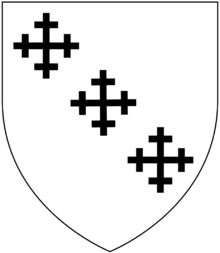
Bridget Maria Stafford, heiress of Pynes, married Sir Henry Northcote, 5th Baronet (1710 – 28 May 1743), of Hayne in the parish of Newton St Cyres near Crediton, a Member of Parliament for Exeter from 1735 until his death in 1743. The estate of Pynes thus passed into the Northcote family. Following his marriage Northcote abandoned the family seat of Hayne, which sank to the status of a farmhouse,[29] and moved to the Stafford seat of Pynes House. In the 1790s the house was occupied by Sir Stafford Henry Northcote, 7th Baronet.[30]
The building was enlarged in 1851 by the statesman Sir Stafford Northcote, 8th Baronet, who in 1885 was created by Queen Victoria 1st Earl of Iddesleigh, which manor had been inherited from the Stafford family with Pynes. In 1852 he added a ceremonial entrance hall, to the design of Ambrose Poynter, for a visit by Queen Victoria.
Walter Stafford Northcote, 2nd Earl of Iddesleigh claimed that Pynes House was the inspiration for Barton Park, which features in Jane Austen's Sense and Sensibility.[31][32]
The Earl of Iddesleigh sold Pynes in 1998.
Notes
- This arrangement is visible on the monument and effigy of Edmund Larder (died 1521) in Upton Pyne Church
- His father is described in Vivian, p.712 as "of Pynes" and was buried in Upton Pyne Church
- In the Treatise he tells of a famous apple tree he was familiar with, growing in the small garden of a humble dwelling-house in Exeter the juice of which produced sufficient income to pay off the mortgage on the property. Rev. Robert Woolcombe, Rector of Whitestone, grafted from this tree, which he named the "Royal Wilding" and produced famous cider from his orchards. Stafford, acqainted with him, experimented himself with growing his own "wildings" from various seeds, and wrote to his friend as follows:[18]
- "I had no opportunity of making a trial of them by themselves, until the memorable year 1724. And then they afforded me a whole pipe of the liquor; which when rack'd and fined, about February, to my no small pleasure, in the opinion, and to the admiration of every one as well as myself, ravish'd the palm from Mr. Woolcombe's Royal Wilding; and was, in a pleasant Conversation, named by a gentleman, who thought it deserved a high title, Super Celestial. Another gentleman, in allusion to Pynes, the name of my house, and to the common story of the West-India Pyne-apple, (which is said to be the finest fruit in the world, and to represent every exquisite flavour that is known) determined, it would be called the Pyne-apple: and by either of these names indifferently it is talked of, (for alas! it is long since drank out, nor hath any other bountiful year as yet yielded another supply) when pleasantry and conversation bring the remembrance of it to the table, which it will ever do until some happy season shall again bring more of the liquor itself there".
- Stafford Barton, the family home of the Stofford/Stafford/Kellaways for about 700 years is close to Dolton and the churches of these villages contain several monuments to the family including stained glass windows, carved bench ends and burial tablets.[20]
- As is apparent from the Stafford/Stowford ledger stones in Dowland Church
References
- Pole, pp. 236–7
- White, William (1879). History, gazetteer and directory of the county of Devon: including the city of Exeter, and comprising a general survey of the county ... (Public domain ed.). White. pp. 835–. Retrieved 30 December 2011.
- Pole, p.237
- Vivian, p.524
- "Church of Our Lady, Upton Pyne, Devon - 14th August 2004". Roughwood web site. Retrieved 6 November 2016.
- Pole, p.132
- Vivian, pp. 102–3;
- Vivian, p.721
- Vivian, pp. 232; 524
- Risdon, p.237
- Vivian, p.232
- Vivian, pp. 232, 227, 224
- Vivian, p.228
- Baring-Gould
- Lauder, Rosemary (2002). Devon Families. Tiverton: Halsgrove. p. 111. ISBN 1841141402.
- Risdon, Tristram (died 1640), Survey of Devon, 1811 edition, London, 1811, with 1810 Additions, p.371
- Stafford (1753)
- Stafford (1753), p.13
- Baring-Gould, Sabine (1908). "Hugh Stafford and the Royal Wilding". Devonshire Characters and Strange Events. London: John Lane, The Bodley Head. Retrieved 6 November 2016.
- "The villages of Dolton, Dowland and Iddesleigh". LESLEY′S ENGLISH ORIGINS. Genealogy Pages. Retrieved 6 November 2016.
- Prince, John (1810). The Worthies of Devon. p. 727. Retrieved 6 November 2016.
- Hoskins, W.G., A New Survey of England: Devon, London, 1959 (first published 1954), p.390
- Vivian, p.510, "Thomas Kelloway alias Stafford",
- Vivian, p.510, pedigree of Kelloway of Stowford
- Vivian, pp.712, pedigree of Stafford; 248, pedigree of Courtenay
- Vivian, p.247
- Vivian, p.510
- Incledon, Benjamin (1802). "Appendix 1". Donations of Peter Blundell, founder, and other benefactors to the free school. p. 49. Retrieved 6 November 2016.
- Lauder, p.111
- Polwhele, Richard (1792). Poems, chiefly by gentlemen of Devonshire and Cornwall: In two volumes. ... Printed by R. Cruttwell; and sold by T. Cadell, C. Dilly, and G. G. J. and J. Robinson, London; Fletcher, Oxford; and Merrill, Cambridge. p. 149. Retrieved 30 December 2011.
- Southam, B. C. (1996). Jane Austen: the critical heritage. 1870–1940. Psychology Press. p. 57. ISBN 978-0-415-13457-6.
- See, for instance, Wakefield, J. F. "Jane Austen's life, times and works explained and discussed – Pynes". Austenonly. Retrieved 2012-01-02.
Sources
- Pole, Sir William (1791). Sir John-William de la Pole (ed.). Collections Towards a Description of the County of Devon. London. Retrieved 6 November 2016.
- Stafford, Hugh (1753). A treatise on cyder-making, with a catalogue of cyder-apples of character, in Herefordshire and Devonshire. To which is prefixed, A dissertation on cyder and cyder-fruit. London. Retrieved 6 November 2016.
- Vivian, J.L. (1895). The Visitations of the County of Devon, 1531, 1564 and 1620. With additions. Part 1. Salt Lake city, Utah: Genealogical Society of the Church Of Jesus Christ of Latter Day Saints. pp. 1–436. Retrieved 6 November 2016.
- Vivian, J.L. (1895). The Visitations of the County of Devon, 1531, 1564 and 1620. With additions. Part 2. pp. 437–899. Retrieved 6 November 2016.